Multi-Morphological Characteristics of a Crushed Granitic Rock of Varying Sizes
Abstract
:1. Introduction
2. Materials and Methods
2.1. Sand and Gravel Particles
2.2. Testing Apparatus
2.3. Morphological Descriptors
3. Results
3.1. Morphological Descriptors at Different Scales
3.2. Average Morphological Descriptors with Particle Size
4. Discussion and Implications
4.1. Comparison of Morphological Descriptors of Crushed Particles with Particles of Weathered Origin
4.2. Role of Mineral Type
4.3. Implications
5. Conclusions
Author Contributions
Funding
Data Availability Statement
Acknowledgments
Conflicts of Interest
References
- Carrier, W.D. Goodbye, Hazen; Hello, Kozeny-Carman. J. Geotech. Geoenviron. Eng. 2003, 129, 1054–1056. [Google Scholar] [CrossRef]
- Cho, G.-C.; Dodds, J.; Santamarina, J.C. Particle Shape Effects on Packing Density, Stiffness, and Strength: Natural and Crushed Sands. J. Geotech. Geoenviron. Eng. 2006, 132, 591–602. [Google Scholar] [CrossRef] [Green Version]
- Senetakis, K.; Coop, M.R.; Todisco, M.C. The inter-particle coefficient of friction at the contacts of Leighton Buzzard sand quartz minerals. Soils Found. 2013, 53, 746–755. [Google Scholar] [CrossRef] [Green Version]
- Yang, H.; Khoshghalb, A.; Russell, A. Fractal-based estimation of hydraulic conductivity from soil–water characteristic curves considering hysteresis. Geotech. Lett. 2014, 4, 1–10. [Google Scholar] [CrossRef]
- Russell, A. How water retention in fractal soils depends on particle and pore sizes, shapes, volumes and surface areas. Géotechnique 2014, 64, 379–390. [Google Scholar] [CrossRef]
- Yang, J.; Luo, X.D. Exploring the relationship between critical state and particle shape for granular materials. J. Mech. Phys. Solids 2015, 84, 196–213. [Google Scholar] [CrossRef]
- Sandeep, C.S.; He, H.; Senetakis, K. An experimental micromechanical study of sand grain contacts behavior from different geological environments. Eng. Geol. 2018, 246, 176–186. [Google Scholar] [CrossRef]
- Holzer, L.; Flatt, R.J.; Erdoğan, S.T.; Bullard, J.W.; Garboczi, E.J. Shape Comparison between 0.4–2.0 and 20–60 μm Cement Particles. J. Am. Ceram. Soc. 2010, 93, 1626–1633. [Google Scholar] [CrossRef]
- Garboczi, E.J.; Liu, X.; Taylor, M.A. The 3-D shape of blasted and crushed rocks: From 20 μm to 38 mm. Powder Technol. 2012, 229, 84–89. [Google Scholar] [CrossRef]
- Bullard, J.W.; Garboczi, E.J. Defining shape measures for 3D star-shaped particles: Sphericity, roundness, and dimensions. Powder Technol. 2013, 249, 241–252. [Google Scholar] [CrossRef]
- Bagheri, G.H.; Bonadonna, C.; Manzella, I.; Vonlanthen, P. On the characterization of size and shape of irregular particles. Powder Technol. 2015, 270, 141–153. [Google Scholar] [CrossRef]
- Krinsley, D.H.; Doornkamp, J.C. Atlas of Quartz Sand Surface Textures; Cambridge University Press: Cambridge, UK, 2011. [Google Scholar]
- Berner, R.A.; Holdren, G.R. Mechanism of feldspar weathering—II. Observations of feldspars from soils. Geochim. Cosmochim. Acta 1979, 43, 1173–1186. [Google Scholar] [CrossRef]
- Anbeek, C. Surface roughness of minerals and implications for dissolution studies. Geochim. Cosmochim. Acta 1992, 56, 1461–1469. [Google Scholar] [CrossRef]
- Lee, M.R.; Parsons, I. Microtextural controls of weathering of perthitic alkali feldspars. Geochim. Cosmochim. Acta 1995, 59, 4465–4488. [Google Scholar] [CrossRef]
- Attal, M.; Lavé, J. Pebble abrasion during fluvial transport: Experimental results and implications for the evolution of the sediment load along rivers. J. Geophys. Res. Earth Surf. 2009, 114, F04023. [Google Scholar] [CrossRef]
- Yao, T.; Baudet, B.A.; Lourenço, S.D.N. Quantification of the surface roughness of quartz sand using optical interferometry. Meccanica 2018, 54, 741–748. [Google Scholar] [CrossRef]
- Altuhafi, F.; Coop, M. Changes to particle characteristics associated with the compression of sands. Géotechnique 2011, 61, 459–471. [Google Scholar] [CrossRef]
- Alshibli, K.A.; Druckrey, A.M.; Al-Raoush, R.I.; Weiskittel, T.; Lavrik, N.V. Quantifying Morphology of Sands Using 3D Imaging. J. Mater. Civ. Eng. 2015, 27, 04014275. [Google Scholar] [CrossRef]
- Yang, H.-W.; Lourenço, S.D.; Baudet, B.A. 3D fractal analysis of multi-scale morphology of sand particles with μCT and interferometer. Géotechnique 2022, 72, 20–33. [Google Scholar] [CrossRef]
- Yang, H.-W.; Lourenço, S.D.; Baudet, B.A.; Choi, C.; Ng, C.W. 3D Analysis of gravel surface texture. Powder Technol. 2019, 346, 414–424. [Google Scholar] [CrossRef]
- Persson, B.; Albohr, O.; Tartaglino, U.; Volokitin, A.; Tosatti, E. On the nature of surface roughness with application to contact mechanics, sealing, rubber friction and adhesion. J. Phys. Condens. Matter 2004, 17, R1–R62. [Google Scholar] [CrossRef] [PubMed] [Green Version]
- Yang, H.-W.; Baudet, B.A.; Yao, T. Characterization of the surface roughness of sand particles using an advanced fractal approach. Proc. R. Soc. A Math. Phys. Eng. Sci. 2016, 472, 20160524. [Google Scholar] [CrossRef] [PubMed] [Green Version]
- Vo, T.; Yang, H.; Russell, A.R. Cohesion and suction induced hang-up in ore passes. Int. J. Rock Mech. Min. Sci. 2016, 87, 113–128. [Google Scholar] [CrossRef]
- Wadell, H. Sphericity and Roundness of Rock Particles. J. Geol. 1933, 41, 310–331. [Google Scholar] [CrossRef]
- Zingg, T. Beitrag zur Schotteranalyse. Ph.D. Thesis, Eidgenössische Technische Hochschule Zürich, Zürich, Switzerland, 1935. [Google Scholar]
- Fonseca, J.; O’Sullivan, C.; Coop, M.; Lee, P. Non-invasive characterization of particle morphology of natural sands. Soils Found. 2012, 52, 712–722. [Google Scholar] [CrossRef]
- Zhao, B.; Wang, J. 3D quantitative shape analysis on form, roundness, and compactness with μCT. Powder Technol. 2015, 291, 262–275. [Google Scholar] [CrossRef] [Green Version]
- Dong, C.-S.; Wang, G.-Z. Curvatures estimation on triangular mesh. J. Zhejiang Univ.-Sci. A 2005, 6, 128–136. [Google Scholar] [CrossRef]
- Zhou, B.; Wang, J.; Wang, H. Three-dimensional sphericity, roundness and fractal dimension of sand particles. Géotechnique 2018, 68, 18–30. [Google Scholar] [CrossRef]
- Szerakowska, S.; Woronko, B.; Sulewska, M.J.; Oczeretko, E. Spectral method as a tool to examine microtextures of quartz sand-sized grains. Micron 2018, 110, 36–45. [Google Scholar] [CrossRef]
- Su, D.; Yan, W. 3D characterization of general-shape sand particles using microfocus X-ray computed tomography and spherical harmonic functions, and particle regeneration using multivariate random vector. Powder Technol. 2017, 323, 8–23. [Google Scholar] [CrossRef]
- Keulen, N.; Heilbronner, R.; Stünitz, H.; Boullier, A.-M.; Ito, H. Grain size distributions of fault rocks: A comparison between experimentally and naturally deformed granitoids. J. Struct. Geol. 2007, 29, 1282–1300. [Google Scholar] [CrossRef] [Green Version]
- Erdoğan, S.; Nie, X.; Stutzman, P.; Garboczi, E. Micrometer-scale 3-D shape characterization of eight cements: Particle shape and cement chemistry, and the effect of particle shape on laser diffraction particle size measurement. Cem. Concr. Res. 2010, 40, 731–739. [Google Scholar] [CrossRef]
- Gharahbagh, E.A.; Qiu, T.; Rostami, J. Evaluation of Granular Soil Abrasivity for Wear on Cutting Tools in Excavation and Tunneling Equipment. J. Geotech. Geoenviron. Eng. 2013, 139, 1718–1726. [Google Scholar] [CrossRef]
- Sebastiani, D.; Miliziano, S.; Guida, G.; Casini, F. Preliminary Evidences on the Influence of Grains Micro-Structural Features on the TBM Tools Wear In Geotechnical Aspects of Underground Construction in Soft Ground; CRC Press: Boca Raton, FL, USA, 2021; pp. 401–407. [Google Scholar]
- Hanaor, D.A.H.; Gan, Y.; Revay, M.; Airey, D.W.; Einav, I. 3D printable geomaterials. Géotechnique 2016, 66, 323–332. [Google Scholar] [CrossRef]
- Wei, D.; Wang, J.; Nie, J.; Zhou, B. Generation of realistic sand particles with fractal nature using an improved spherical harmonic analysis. Comput. Geotech. 2018, 104, 1–12. [Google Scholar] [CrossRef]
- Zhou, B.; Wei, D.; Ku, Q.; Wang, J.; Zhang, A. Study on the effect of particle morphology on single particle breakage using a combined finite-discrete element method. Comput. Geotech. 2020, 122, 103532. [Google Scholar] [CrossRef]
- Otsubo, M.; O’Sullivan, C.; Sim, W.W.; Ibraim, E. Quantitative assessment of the influence of surface roughness on soil stiffness. Géotechnique 2015, 65, 694–700. [Google Scholar] [CrossRef] [Green Version]
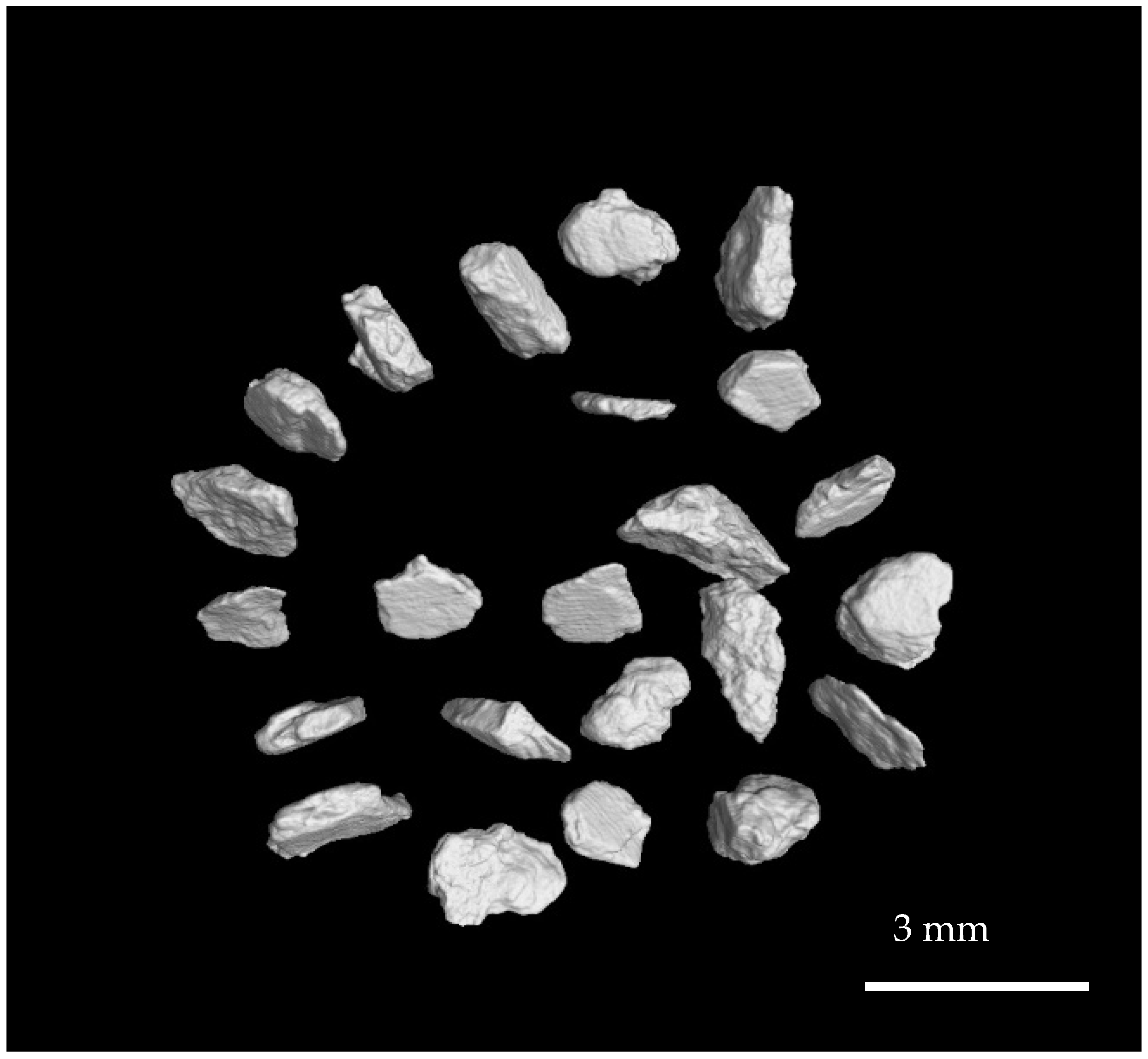
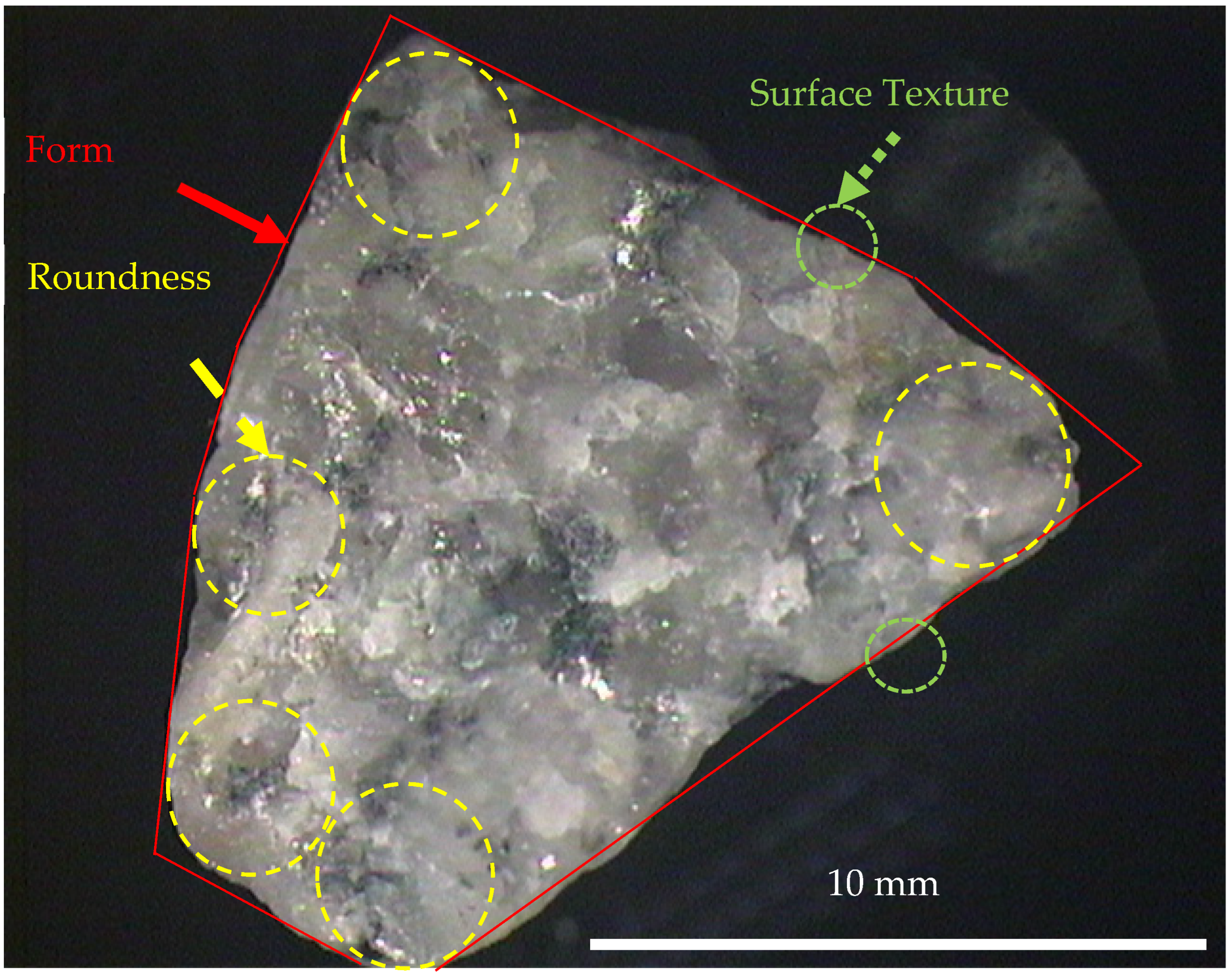
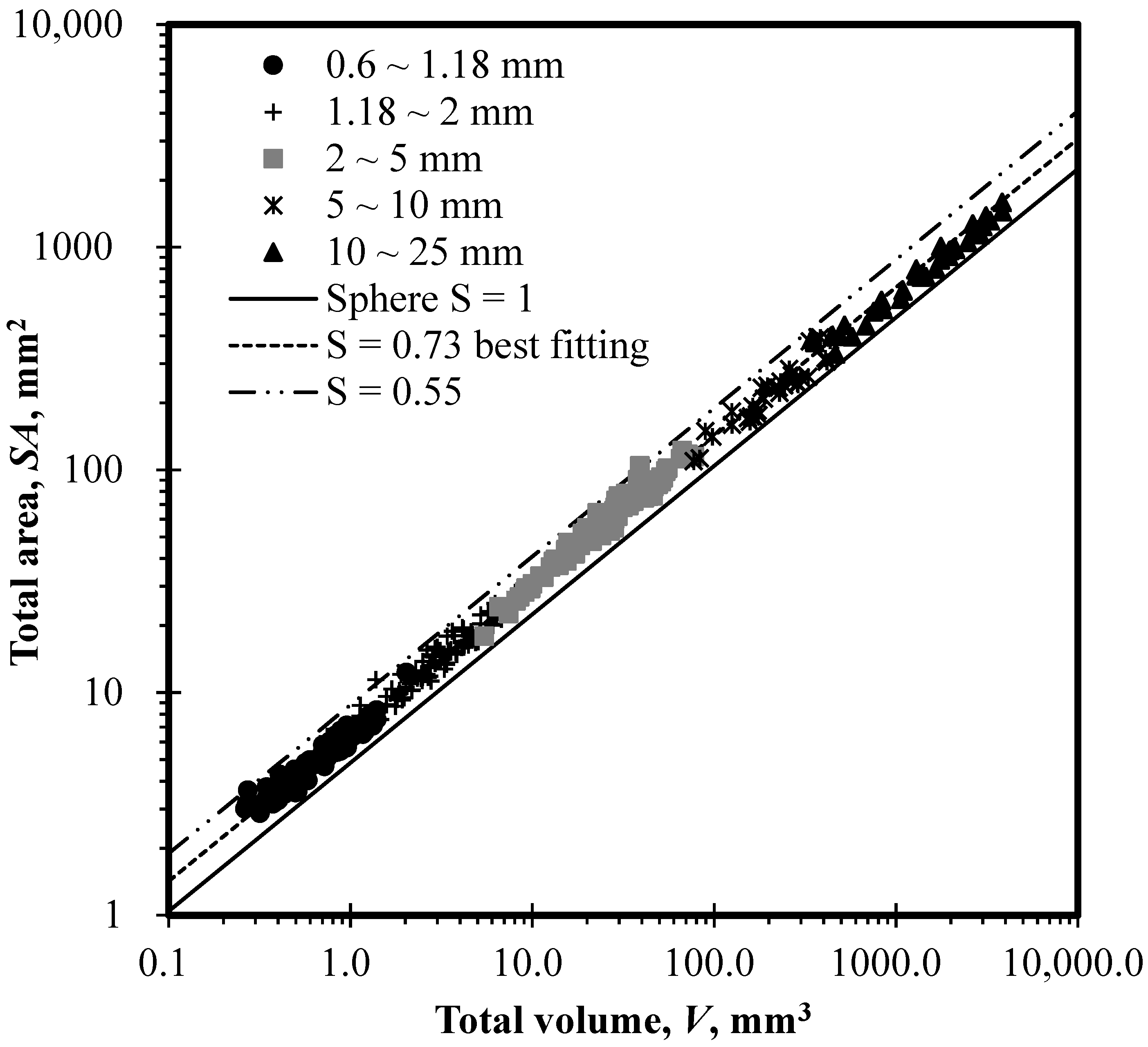

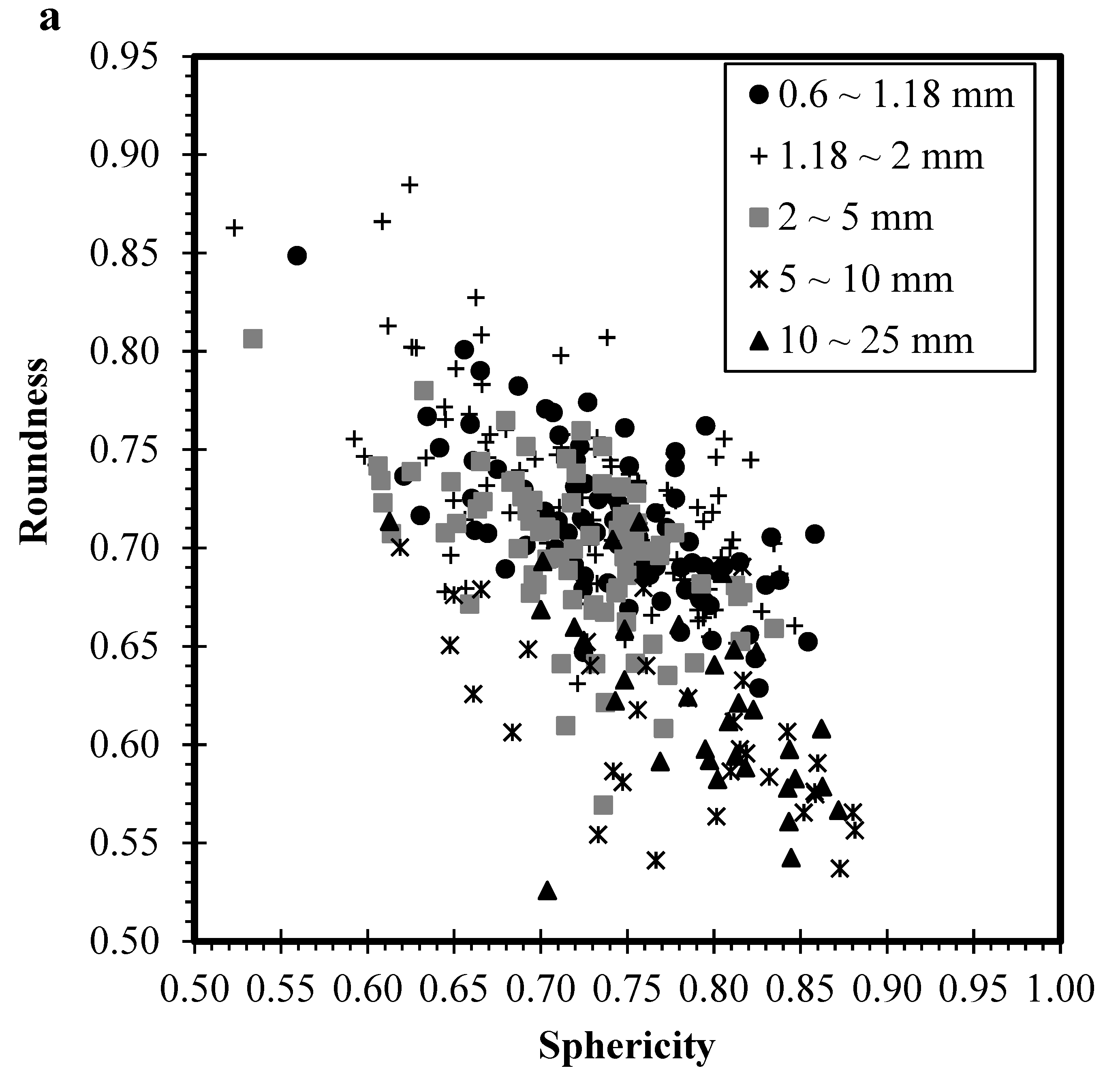
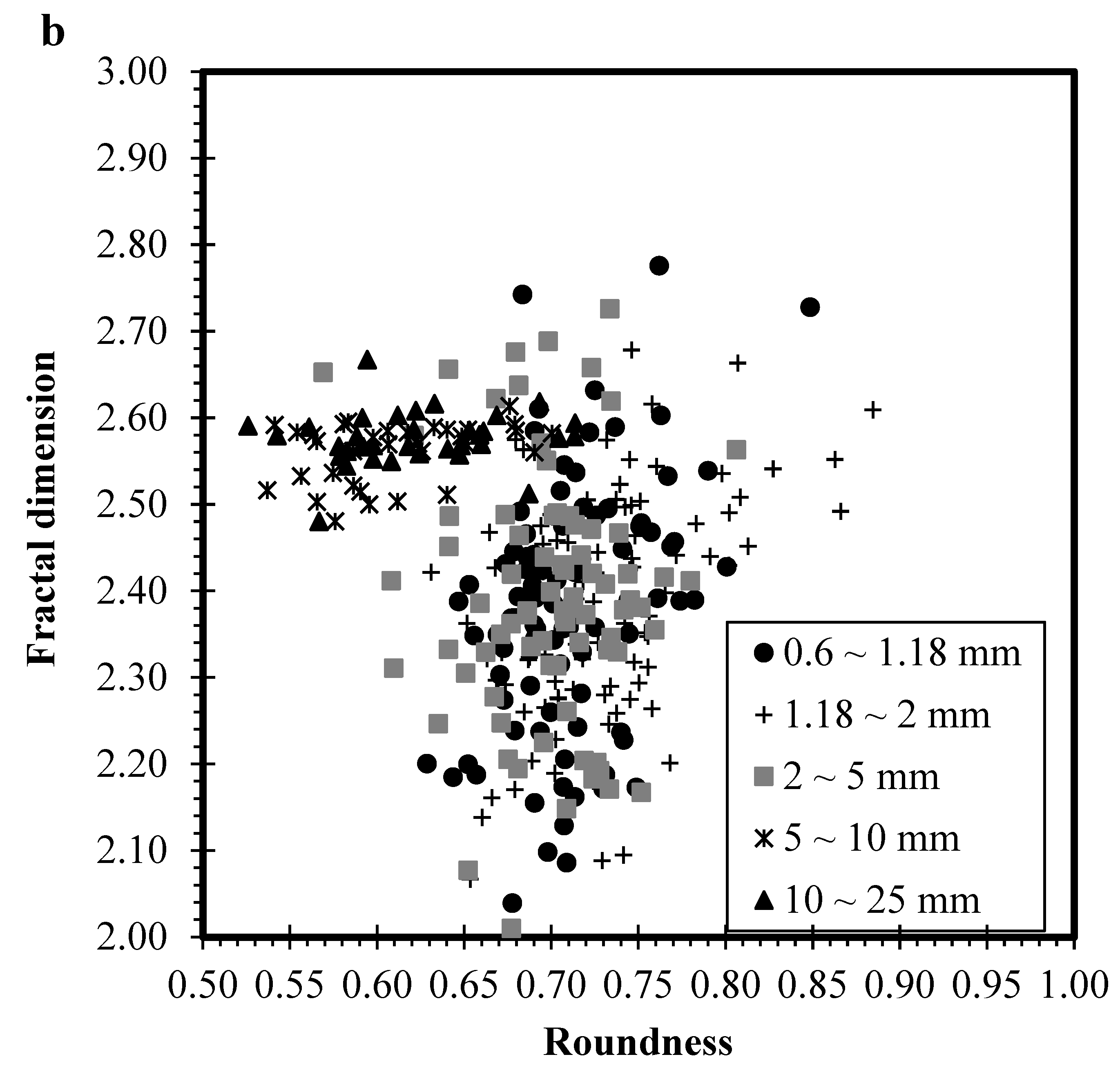
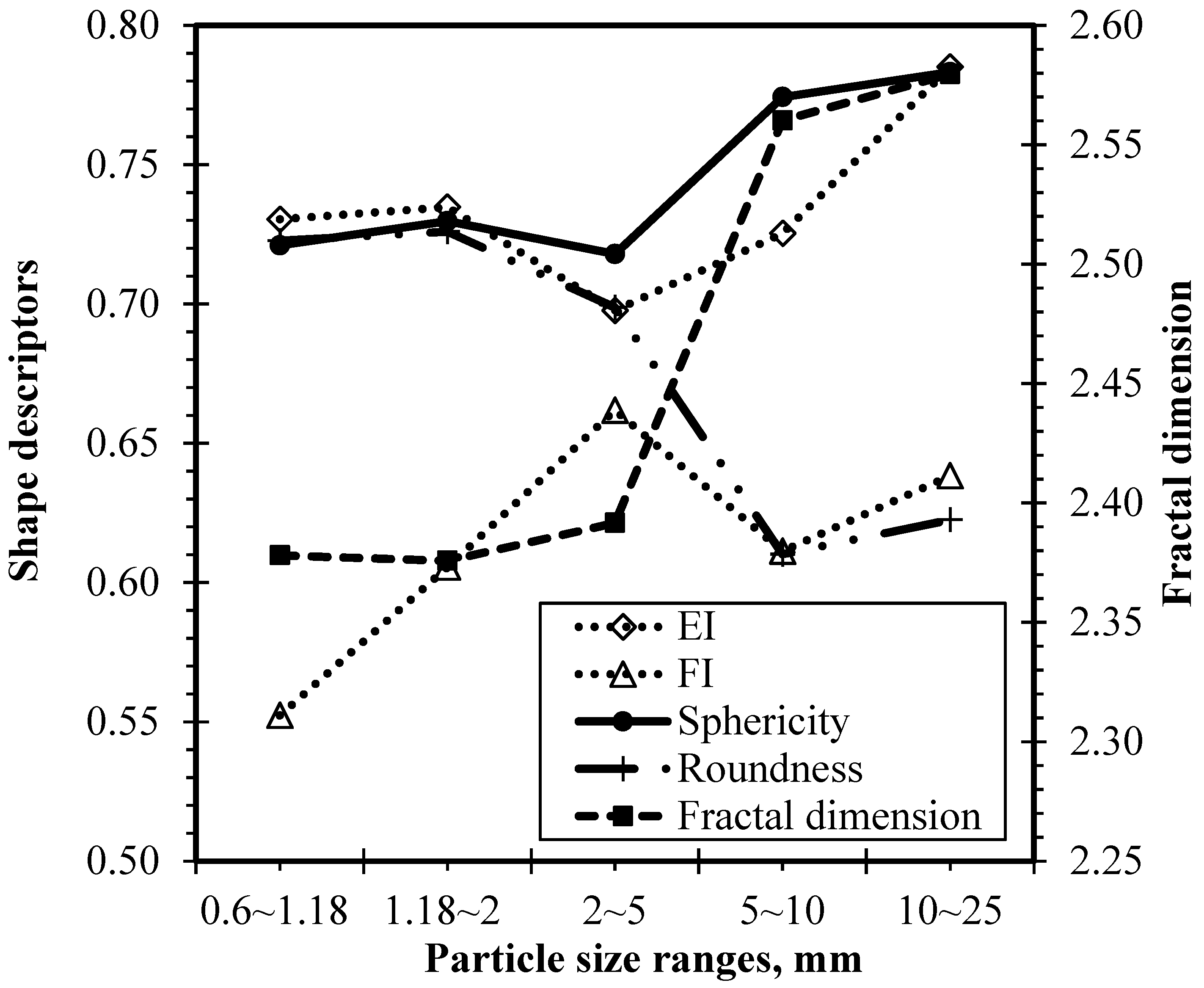
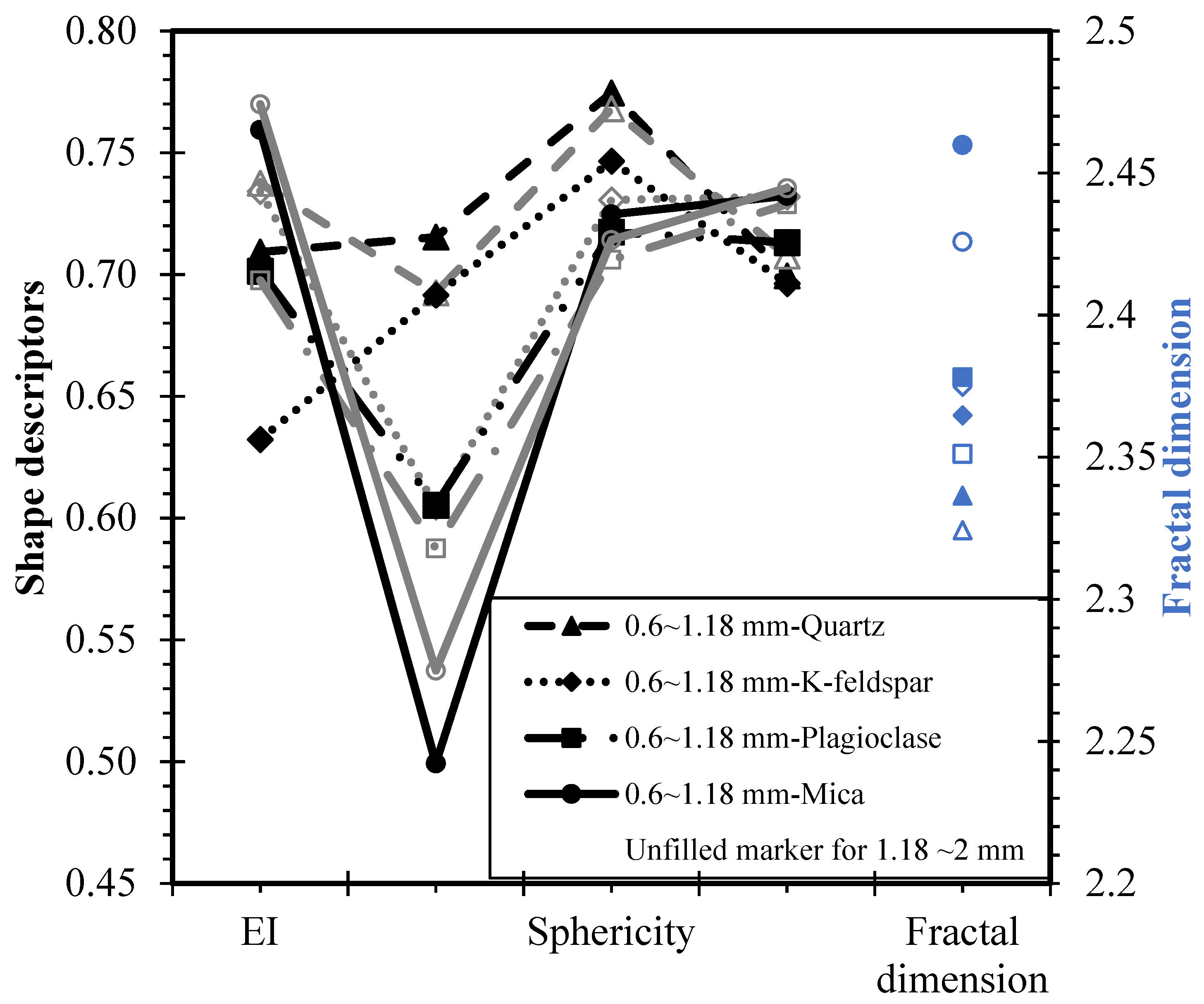
| Particle Size, mm | Aspect Ratio | Sphericity | Roundness | Fractal Dimension | |||||||
|---|---|---|---|---|---|---|---|---|---|---|---|
| EL | FL | ||||||||||
| Mean | Standard Deviation | Mean | Standard Deviation | Mean | Standard Deviation | Mean | Standard Deviation | Mean | Standard Deviation | ||
| 0.6~1.18 | Quartz | 0.71 | 0.10 | 0.72 | 0.12 | 0.77 | 0.04 | 0.70 | 0.03 | 2.34 | 0.12 |
| K-feldspar | 0.63 | 0.14 | 0.69 | 0.16 | 0.75 | 0.05 | 0.70 | 0.03 | 2.36 | 0.13 | |
| Plagioclase | 0.70 | 0.15 | 0.61 | 0.17 | 0.72 | 0.05 | 0.71 | 0.04 | 2.35 | 0.15 | |
| Mica | 0.76 | 0.13 | 0.50 | 0.18 | 0.72 | 0.07 | 0.73 | 0.04 | 2.46 | 0.17 | |
| average | 0.71 | 0.14 | 0.63 | 0.18 | 0.74 | 0.06 | 0.71 | 0.04 | 2.38 | 0.15 | |
| 1.18~2 | Quartz | 0.74 | 0.09 | 0.69 | 0.16 | 0.77 | 0.05 | 0.71 | 0.03 | 2.33 | 0.12 |
| K-feldspar | 0.73 | 0.15 | 0.60 | 0.15 | 0.73 | 0.05 | 0.73 | 0.04 | 2.37 | 0.12 | |
| Plagioclase | 0.70 | 0.13 | 0.59 | 0.17 | 0.71 | 0.07 | 0.73 | 0.05 | 2.38 | 0.16 | |
| Mica | 0.77 | 0.14 | 0.54 | 0.15 | 0.71 | 0.07 | 0.74 | 0.06 | 2.43 | 0.10 | |
| average | 0.73 | 0.17 | 0.60 | 0.17 | 0.73 | 0.07 | 0.73 | 0.05 | 2.38 | 0.13 | |
| 2~5 | 0.70 | 0.13 | 0.66 | 0.17 | 0.72 | 0.05 | 0.70 | 0.04 | 2.39 | 0.15 | |
| 5~10 | 0.73 | 0.12 | 0.61 | 0.17 | 0.77 | 0.08 | 0.61 | 0.04 | 2.56 | 0.04 | |
| 10~25 | 0.79 | 0.12 | 0.64 | 0.16 | 0.78 | 0.06 | 0.62 | 0.05 | 2.58 | 0.04 | |
Publisher’s Note: MDPI stays neutral with regard to jurisdictional claims in published maps and institutional affiliations. |
© 2022 by the authors. Licensee MDPI, Basel, Switzerland. This article is an open access article distributed under the terms and conditions of the Creative Commons Attribution (CC BY) license (https://creativecommons.org/licenses/by/4.0/).
Share and Cite
Yang, H.; Xu, Z.; Cheng, Y. Multi-Morphological Characteristics of a Crushed Granitic Rock of Varying Sizes. Minerals 2022, 12, 522. https://doi.org/10.3390/min12050522
Yang H, Xu Z, Cheng Y. Multi-Morphological Characteristics of a Crushed Granitic Rock of Varying Sizes. Minerals. 2022; 12(5):522. https://doi.org/10.3390/min12050522
Chicago/Turabian StyleYang, Hongwei, Zhengyang Xu, and Yan Cheng. 2022. "Multi-Morphological Characteristics of a Crushed Granitic Rock of Varying Sizes" Minerals 12, no. 5: 522. https://doi.org/10.3390/min12050522
APA StyleYang, H., Xu, Z., & Cheng, Y. (2022). Multi-Morphological Characteristics of a Crushed Granitic Rock of Varying Sizes. Minerals, 12(5), 522. https://doi.org/10.3390/min12050522






